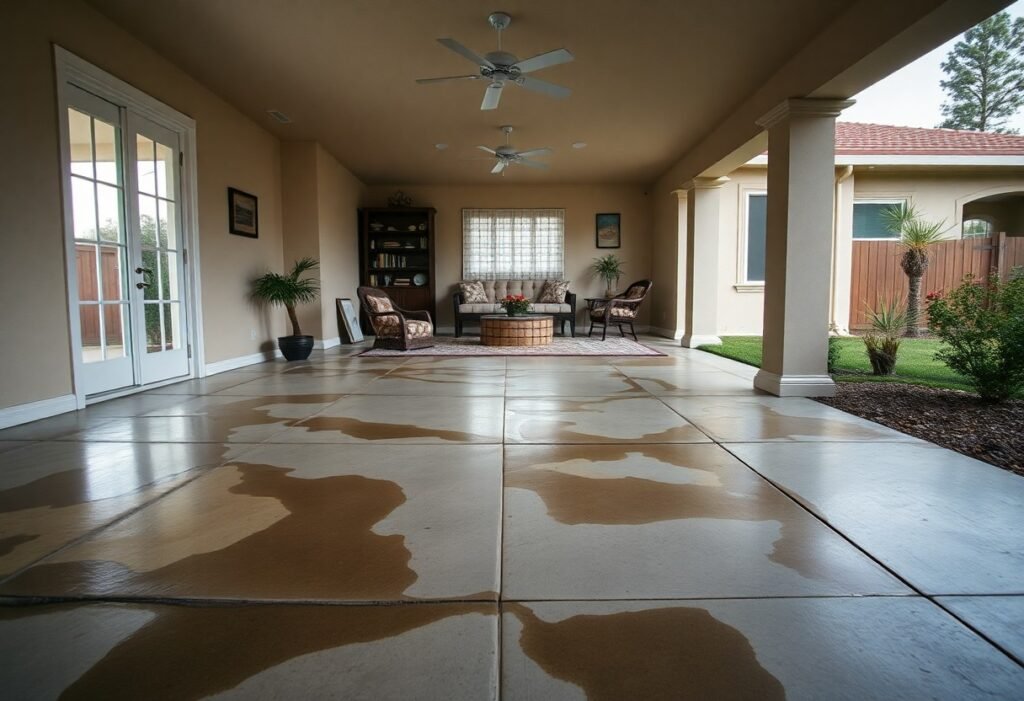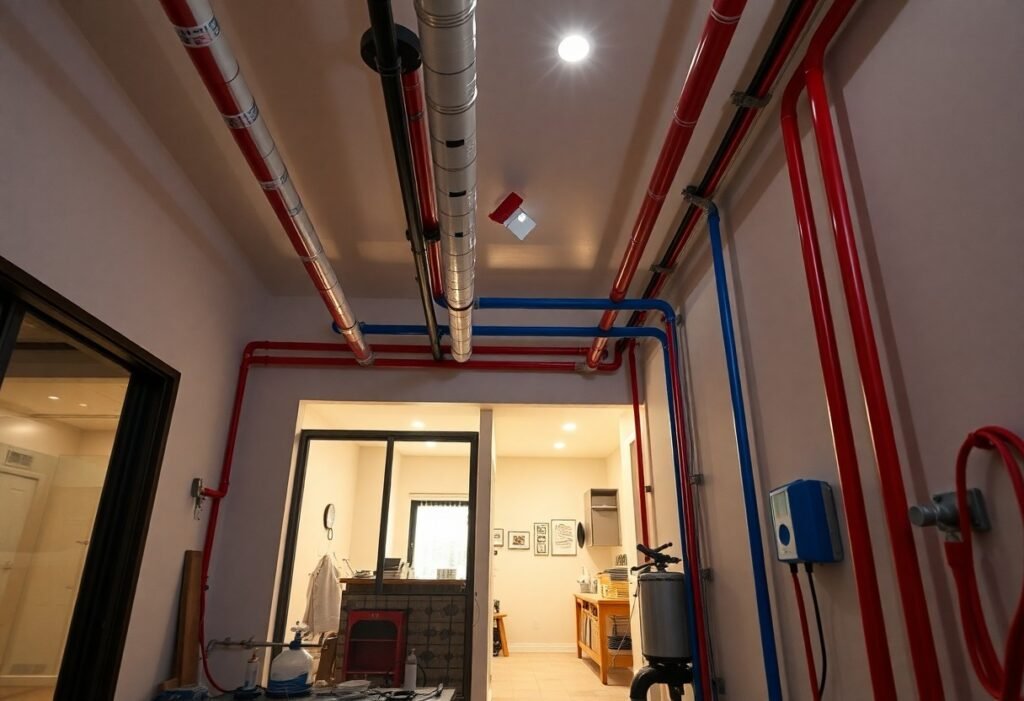Placentia, California – Copper vs. PEX for Your Whole House Repipe

You may be considering a whole house repipe in Placentia, California, and wondering whether to choose copper or PEX. Each option has its unique strengths and weaknesses that can significantly impact your home’s plumbing system. Copper pipes are known for their durability and resistance to corrosion but come with a higher price tag. On the other hand, PEX piping is flexible, cost-effective, and resistant to scaling and chlorine, making it a popular choice among homeowners. In this post, we will explore the pros and cons of both materials to help you make an informed decision.
Key Takeaways:
- Copper piping is durable and has a long lifespan, but it can be more expensive and requires professional installation.
- PEX (cross-linked polyethylene) is flexible, easier to install, and often more cost-effective, making it a popular choice for residential repiping.
- Consider local building codes and your home’s specific plumbing needs when choosing between copper and PEX for a whole house repipe in Placentia, California.
The Battle of Materials: Copper vs. PEX
Choosing between copper and PEX for your whole house repipe involves evaluating the advantages and disadvantages of each material. Copper boasts a long history of reliability and durability, while PEX offers remarkable flexibility and ease of installation. Understanding these materials will help you make an informed decision for your home plumbing system.
Historical Significance and Durability of Copper
Copper has been a go-to material for plumbing since ancient times due to its inherent durability and resistance to corrosion. With a lifespan of 50 years or more, copper piping remains a trusted option for homeowners seeking longevity. Its ability to withstand extreme temperatures and pressures further solidifies its position as a reliable choice for repiping projects. Moreover, copper is a natural antimicrobial material, reducing the risk of bacteria buildup in your water supply.
The Rise of PEX: Flexibility and Modern Engineering
PEX, or cross-linked polyethylene, has rapidly gained popularity in recent years due to its flexibility and innovative engineering. This flexible piping can bend around corners and navigate complex plumbing layouts with ease, minimizing the number of fittings and joints required during installation. This efficiency not only reduces labor costs but also helps to mitigate potential leak points, making PEX a practical choice for modern plumbing systems.
Additionally, PEX can withstand extreme temperatures and pressures without cracking or breaking, unlike traditional materials. Its resistance to scale and chlorine makes it advantageous for areas with hard water. Installation is notably easier and faster, often allowing for DIY projects when combined with joiners and connectors. As a non-metal material, PEX won’t corrode over time, ensuring that your plumbing stays functional for years to come. With lower material costs and minimal labor, it has become a favorite among contractors and homeowners alike.
Cost Analysis: Short-Term vs. Long-Term Value
In evaluating your options for repiping, it’s crucial to weigh the short-term costs against the long-term benefits. While copper pipes may have a higher upfront expense—averaging between $2.50 and $7 per linear foot—PEX can be more budget-friendly, costing around $0.50 to $2 per linear foot. However, the longevity and reduced maintenance costs of copper can make it a wise investment in the long run. For those interested in local service providers, you can find the TOP 10 BEST Repiping near Placentia, CA – Updated 2025.
Initial Installation Costs: Breaking Down the Numbers
The initial installation costs reflect more than the material; labor can significantly influence the overall price. On average, you might pay around $1,500 to $15,000 or more for a whole-house repipe, depending on your home’s size and the complexity of the job. While PEX tends to lower labor costs due to its ease of installation, copper might require skilled laborers to ensure a quality job, thus increasing the overall price tag.
Long-Term Maintenance and Lifespan Considerations
Long-term maintenance and lifespan of your piping system play a considerable role in your decision-making process. Copper pipes can last from 50 to 70 years but may require periodic soldering at joints, leading to potential costs over time. In contrast, PEX pipes come with a lifespan of around 30 to 50 years and are less prone to leaks due to their flexibility. However, they may be more susceptible to damage from UV exposure and chemical reactions, thus requiring more careful consideration.
Considering maintenance, copper pipes’ durability can offset their high installation cost over decades, whereas PEX’s low initial cost may leave you with repairs or replacements sooner. You can avoid costly corrosion issues typically associated with copper by choosing PEX. However, protecting PEX from sunlight and ensuring proper installation are crucial to maximize its lifespan. Familiarity with your home’s specific needs can help you make an informed choice that balances both immediate and future costs effectively.
Environmental Impact: Sustainability in Home Plumbing
Evaluating the environmental impact of your plumbing choices plays a vital role in sustainable home improvements. Both copper and PEX offer unique benefits and drawbacks when it comes to their ecological footprints. Copper is durable and long-lasting, reducing the need for frequent replacements, but its mining can be environmentally damaging. PEX, while not requiring as much energy to manufacture, has concerns regarding its chemical leaching over time. Understanding these factors helps you make more informed decisions that align with your sustainability goals.
Energy Efficiency and Resource Usage
PEX is known for its superior energy efficiency due to its insulation properties, which can reduce heat loss when transporting hot water. This results in less energy required to heat your water, translating to lower utility bills and reduced carbon emissions over time. In contrast, copper’s high thermal conductivity means it allows heat to escape more easily, requiring more energy to maintain water temperatures. By selecting a more energy-efficient option like PEX, you contribute to lower resource usage within your home.
Recyclability and End-of-Life Considerations
With respect to recyclability, copper holds a significant advantage over PEX. Copper is 100% recyclable and retains its value even after it has been used, making it an attractive option for eco-conscious homeowners. PEX, however, is not recyclable in traditional terms, leading to concerns about its disposal and long-term environmental impact. Understanding how these materials fare at the end of their life cycle is necessary for making a responsible choice.
While PEX may not be recyclable, some companies are exploring innovative ways to process it, potentially reducing its environmental footprint. The longevity of copper plumbing means that it can be reused indefinitely, diminishing the need for new raw materials. By choosing a product with a longer lifespan, you not only decrease waste but also help conserve natural resources. For those committed to environmental sustainability, the choice of copper may ultimately align better with your values, as it encourages recycling and more responsible end-of-life handling.

Professional Perspectives: Insights from Industry Experts
Insights from both veteran plumbers and regulatory bodies shed light on the ongoing debate between copper and PEX. Plumbers advocate for practicality, sharing their first-hand experiences regarding installation ease and long-term performance. On the regulatory side, compliance experts emphasize the importance of adhering to current codes, ensuring safety for homeowners and the community alike. Understanding these perspectives equips you with the knowledge to make an informed decision about your home’s plumbing system.
Plumber Testimonials on Material Performance
Many plumbers endorse PEX for its flexibility and resistance to scale and chlorine, while copper enthusiasts boast about its durability and long-standing track record. One plumber highlighted that “PEX has significantly reduced installation time and labor costs,” while another shared that “copper’s longevity makes it a tried-and-true choice.” Considering the testimonials from industry professionals can be instrumental in determining which material better fits your needs.
Regulatory and Code Compliance Analysis
Focusing on the importance of adhering to plumbing codes, local regulations dictate the allowable materials for residential repiping. These guidelines ensure safety standards and prevent plumbing failures that might impact health and property. Moreover, PEX has gained popularity in many jurisdictions due to its compliance with the Uniform Plumbing Code, while copper still remains a staple under national regulations.
In certain regions, local building codes may have specific stipulations regarding the installation of PEX versus copper. For example, PEX requires specific fittings and installation methods to meet the regulatory standards, which can vary between states. Ensuring that your chosen material aligns with local compliance standards minimizes the risk of future plumbing issues, as well as potential fines or mandated repairs. Engaging with licensed professionals who are knowledgeable about these codes is important for guaranteeing that your repipe meets all legal requirements and best practices.
Homeowner Choices: Making the Right Decision for Your Needs
Choosing the right plumbing material for your whole house repipe ultimately depends on your unique needs and preferences. Factors such as budget, home layout, and personal values can heavily influence your decision. Thoroughly understanding the advantages and disadvantages of both copper and PEX will guide you to align your choice with practical needs and long-term goals.
Evaluating Your Home’s Specific Infrastructure
Your home’s existing plumbing layout can determine the suitability of either copper or PEX. If your infrastructure is complex with tight spaces, PEX’s flexibility and ability to navigate around obstacles may be advantageous. Alternatively, older homes with existing copper pipes may favor replacement with like materials for consistency. Assessing structural compatibility ensures a smoother repiping process.
Lifestyle and Prioritization in Choosing Material
Your lifestyle plays a significant role in the selection process. If you value longevity and aesthetics, copper’s durability and classic appeal may resonate more with you. If you prioritize cost-effectiveness and ease of installation, PEX could be the better fit. Prioritizing what matters most in your daily life will help simplify your material choice.
Additionally, consider how often you use water-intensive appliances or systems like dishwashers and laundry machines. Homeowners with a busy household may lean towards PEX, as its resistance to freezing and bursting means less worry about water damage during cold periods. Conversely, if eco-friendliness and lifespan are paramount, opting for copper, which can last over 50 years with proper care, often becomes the preferred choice. Aligning your material selection with your lifestyle ensures satisfaction and peace of mind in your home for years to come.
Conclusion
With this in mind, choosing between copper and PEX for your whole house repipe in Placentia, California, involves weighing various factors such as budget, longevity, and installation ease. Copper offers durability and a traditional aesthetic, while PEX presents a cost-effective, flexible option that simplifies installation. Ultimately, the decision should align with your specific needs and long-term plans for your home. Consulting with a knowledgeable plumbing professional can provide valuable insights tailored to your situation, ensuring you make an informed choice that enhances your property’s plumbing system.
Q: What are the key differences between copper and PEX pipes for repiping a home in Placentia, California?
A: The primary differences between copper and PEX pipes include material properties, installation method, and cost. Copper pipes are durable, resistant to high temperatures, and do not leach chemicals, making them a traditional choice for plumbing. However, they can be more expensive and require soldering for installation, which can be labor-intensive. On the other hand, PEX (cross-linked polyethylene) is flexible, making it easier to install in tight spaces and can be laid out without fittings for longer runs, reducing the potential for leaks. Additionally, PEX pipes are generally less expensive and lighter than copper, although they may be susceptible to UV damage and are not ideal for outdoor applications.
Q: How does the climate in Placentia, California affect the choice between copper and PEX for plumbing?
A: The climate in Placentia, characterized by mild winters and warm summers, plays a significant role in the choice of piping. Copper has excellent thermal properties and can withstand high temperatures, which can be beneficial in warmer climates. However, it is also prone to freezing and bursting in extremely cold weather if insulation is not applied. PEX, being flexible, is less likely to burst in freezing conditions due to its ability to expand slightly. Moreover, PEX should not be exposed to direct sunlight for extended periods as UV rays can degrade the material, so outdoor applications need careful consideration. Therefore, PEX can be suitable for most indoor applications in Placentia, while copper may be preferred for outdoor and exposed installations.
Q: What factors should homeowners in Placentia consider when deciding between copper and PEX for repiping?
A: Homeowners should consider several factors including budget, installation time, and long-term maintenance. Cost is a significant factor, as PEX is usually cheaper than copper not only in material but also in labor costs due to easier installation. Additionally, the expected lifespan and maintenance requirements will influence the decision; copper can last up to 50 years with proper care, while PEX typically lasts around 25 years but may require replacement more frequently if exposed to harsh conditions. Moreover, homeowners should consider their water quality since PEX is resistant to scale and chlorine while copper can corrode over time depending on local water chemistry. Consulting with plumbing professionals can help determine the best option based on individual circumstances.



